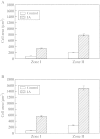Exogenously applied jasmonic acid induces changes in apical meristem morphology of potato stolons
- PMID: 12770846
- PMCID: PMC4242400
- DOI: 10.1093/aob/mcg098
Exogenously applied jasmonic acid induces changes in apical meristem morphology of potato stolons
Abstract
Hooked apex stolons and initial swelling stolons of potato plants were treated with 3 x 10-8 mol l-1 jasmonic acid (JA) to study the effect of this compound on histology, cell expansion and tissue differentiation. In hooked apex stolons, JA application increased the meristem thickness and reduced the length of the leaf primordia, whereas in initial swelling stolons narrowing of the apical region, absence of leaf primordia and swelling of the subapical meristem were evident. Early vascular tissue differentiation was observed in response to JA treatment, especially of xylem elements from regions proximal to the tunic. Protoxylem elements, such as tracheal elements, were present with thin primary cell walls. The cell area was measured in two zones: zone I, central mother cells situated immediately under the tunic; and zone II, rib meristem cells. JA caused a four- and six-fold increase in cell area in both zones in hooked apex stolons and initial swelling stolons, respectively. Thus, tuber formation is concluded to occur as a consequence of increased cell expansion, a reduction in the length of leaf primordia, enlargement of meristems, and early vascular tissue differentiation.
Figures



Similar articles
-
[Changes in the plastid apparatus of apical meristem cells of potato tubers upon growth regulation with jasmonic acid].Prikl Biokhim Mikrobiol. 2010 May-Jun;46(3):385-92. Prikl Biokhim Mikrobiol. 2010. PMID: 20586294 Russian.
-
Cytochemical immuno-localization of allene oxide cyclase, a jasmonic acid biosynthetic enzyme, in developing potato stolons.J Plant Physiol. 2007 Nov;164(11):1449-56. doi: 10.1016/j.jplph.2006.10.007. Epub 2007 Jan 16. J Plant Physiol. 2007. PMID: 17223227
-
Occurrence of 11-hydroxyjasmonic acid glucoside in leaflets of potato plants (Solanum tuberosum L.).Biosci Biotechnol Biochem. 2001 Feb;65(2):378-82. doi: 10.1271/bbb.65.378. Biosci Biotechnol Biochem. 2001. PMID: 11302172
-
[Effect of melafen on mitochondrial apparatus of apical meristem in growth regulation in potato tubers].Prikl Biokhim Mikrobiol. 2011 Jul-Aug;47(4):484-9. Prikl Biokhim Mikrobiol. 2011. PMID: 21950126 Russian.
-
Leaf initiation: the integration of growth and cell division.Plant Mol Biol. 2006 Apr;60(6):905-14. doi: 10.1007/s11103-005-7703-9. Plant Mol Biol. 2006. PMID: 16724260 Review.
Cited by
-
Potato: from functional genomics to genetic improvement.Mol Hortic. 2024 Aug 19;4(1):34. doi: 10.1186/s43897-024-00105-3. Mol Hortic. 2024. PMID: 39160633 Free PMC article. Review.
-
Research progress on the bulb expansion and starch enrichment in taro (Colocasia esculenta (L). Schott).PeerJ. 2023 Jun 8;11:e15400. doi: 10.7717/peerj.15400. eCollection 2023. PeerJ. 2023. PMID: 37309370 Free PMC article. Review.
-
The Arabidopsis Mitogen-Activated Protein Kinase Kinase Kinase 20 (MKKK20) Acts Upstream of MKK3 and MPK18 in Two Separate Signaling Pathways Involved in Root Microtubule Functions.Front Plant Sci. 2017 Aug 8;8:1352. doi: 10.3389/fpls.2017.01352. eCollection 2017. Front Plant Sci. 2017. PMID: 28848569 Free PMC article.
-
Editorial: Cooperation of gene regulatory networks and phytohormones in cell development and morphogenesis.Front Plant Sci. 2023 Oct 4;14:1290538. doi: 10.3389/fpls.2023.1290538. eCollection 2023. Front Plant Sci. 2023. PMID: 37860232 Free PMC article. No abstract available.
-
Exogenous short-term silicon application regulates macro-nutrients, endogenous phytohormones, and protein expression in Oryza sativa L.BMC Plant Biol. 2018 Jan 4;18(1):4. doi: 10.1186/s12870-017-1216-y. BMC Plant Biol. 2018. PMID: 29301510 Free PMC article.
References
-
- AbdalaG, Castro G, Miersch O, Pearce D.2002. Changes in jasmonates and gibberellins during development of potato plant (Solanum tuberosum L.). Plant Growth Regulation 36: 121–126.
-
- AbdalaG, Miersch O, Kramell R, Vigliocco A, Agostini E, Forchetti G, Alemano S.2003. Jasmonate and octadecanoid occurrence in tomato hairy roots. Endogenous level changes in response to NaCl. Plant Growth Regulation 40: 21–27.
-
- AbeM, Shibaoka H, Yamane H, Takahashi N.1990. Cell cycle‐dependent disruption of microtubules by methyl jasmonates in tobacco BY‐2‐cells. Protoplasma 156: 1–8.
-
- BoothA.1963. The role of growth substances in the development of stolons. In: JD Ivins, FL Milthorpe, eds. The growth of the potato London: Butterworth, 99–113.
-
- CastroG, Kraus T, Abdala G.1999. Endogenous jasmonic acid and radial cell expansion in buds of potato tubers. Journal of Plant Physiology 155: 706–710.
Publication types
MeSH terms
Substances
LinkOut - more resources
Full Text Sources
Miscellaneous

